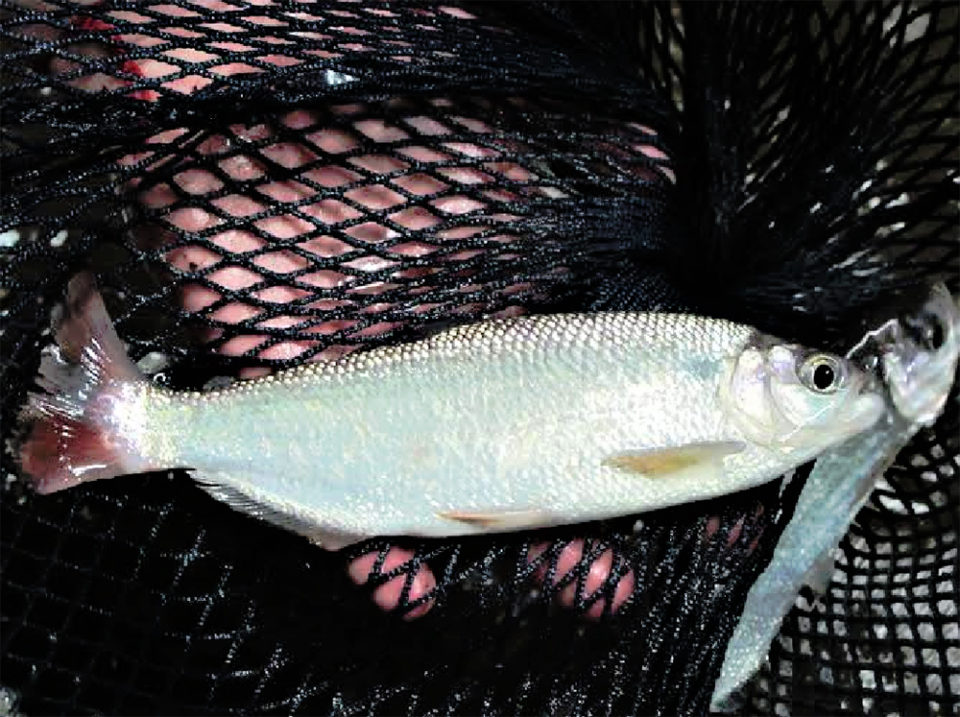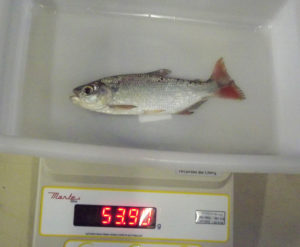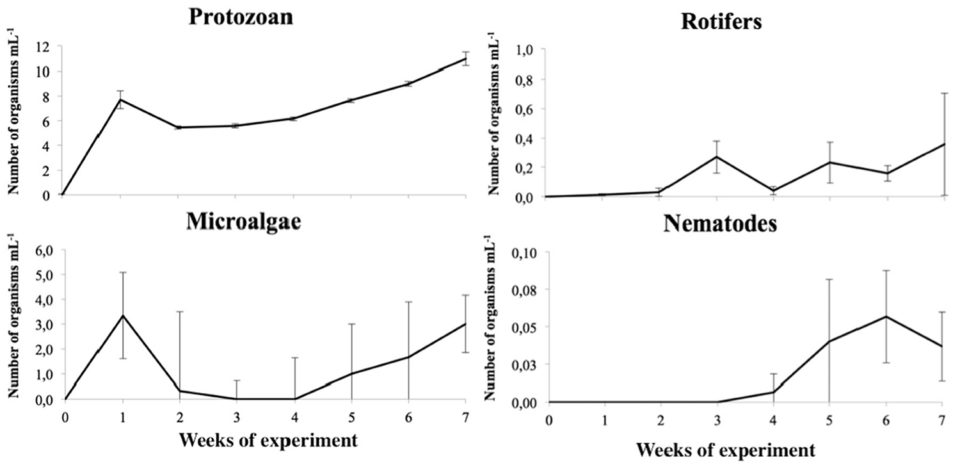Study looks at alternative culture system for South American species

The freshwater fish piracanjuba (Brycon orbignyanus) is a species native to the Uruguay and Parana Rivers and is distributed from Honduras to La Plata River, in Argentina. In recent years, overfishing, river damming and construction of hydroelectric power plants has caused a dramatic reduction of natural stocks.
Some fish stocking programs have been carried out with relatively success. As a result, the farming of piracanjuba has been increasing recently to supply seedstock to re-establish natural stocks and because of favorable growth performance. Other attractive traits of the species for aquaculture include its omnivorous feeding habits, good acceptance of artificial feeds and meat quality.
Biofloc technology (BFT) has been growing in Brazil and elsewhere, as an environmentally friendly system with low water exchange and a reduction in feed use as the biofloc microbial community serves as natural food source.
For the formation of the microbial aggregate, or biofloc, a carbon source is added to the water to promote the growth of an aerobic and heterotrophic biota that may contribute in three main aspects: (i) maintaining water quality by direct assimilation of ammonia nitrogen and generation of microbial protein; (ii) serving as food item for the farmed animals, improving feed conversion and reducing production costs; and (iii) acting as a pathogen competition. These are desirable characteristics for several species and relevant for aquaculture diversification.
This article – adapted and summarized from the original publication [Aquaculture 485 (2018): 119-123] – reports on a study in Brazil to assess growth performance and survival of piracanjuba raised in BFT comparing with a clear-water (CW) recirculated system as control. Piracanjuba naturally lives in turbid waters and could probably benefit from culture in a biofloc environment, and it is still necessary to develop intensive techniques to maximize the production of juveniles.
The authors are thankful to the Santa Catarina Research Foundation for the financial support (PAP-FAPESC 2013TR3406 and 2015TR453), to Mayara Nazário and João Costa Filho for the technical assistance and to all LAQ/UDESC staff.

Study setup
The study was carried out in the Aquaculture Laboratory (LAQ), Santa Catarina State University (UDESC), in Laguna, SC, Brazil. Fish were provided by a commercial hatchery (Piscicultura Panamá, Paulo Lopes, SC, Brazil). Juvenile piracanjuba, 35.4 ± 0.94 grams, were randomly distributed into six 500-liter (350 L actual volume) experimental, aerated tanks referred to as microcosms and at a density of 12 fish per tank (1 kg per cubic meter), three tanks for the BFT system and three tanks for the CW system used as control.
The source of the biofloc water was a super-intensive BFT 1000-L macrocosm tank stocked with Nile tilapia (Oreochromis niloticus) juveniles. To form and maintain the microbial community in BFT, a carbon-nitrogen (C:N) ratio of 20:1 was adopted by daily addition of a mix of carbon sources (corn meal, wheat meal, powder sugar molasses at a ratio of 1:1:2). This ratio was kept throughout the trial, considering the proximate composition of the feed and of the carbon sources. The CW control system included a mechanical filter and a biofilter.
The water exchange rate for both treatment tanks was of approximately 150 percent per day. Water temperature was kept constant in both systems using electric heaters (1 watt per liter). Fish were fed ad libitum using a commercial diet (Presence Nutripisces, 45 percent crude protein, Paulínia, SP, Brazil).
For detailed information on the study setup, system management, data collection and statistical analyses, please refer to the original publication.
Results and discussion

Regarding water quality parameters, dissolved oxygen concentration and temperature were similar between treatments throughout the trial. Water pH was near neutral, with average values of 7.65 in BFT and 6.98 in CW. Mean values of ammonia, nitrite and nitrate in BFT were higher (0.96, 0.10 and 0.90 mg/L) as compared to CW treatment (0.67, 0.03 and 0.74 mg/L). Orthophosphate and alkalinity were also higher in BFT than in CW. Settling solids in the BFT macrocosm varied from 0.30 to 16 mL/L during the trial, with mean value of 4.3 mL/L.
Our results showed nitrite concentrations of 0.10 mg/L in the BFT system (very close to the safety level of 10 percent of LC50) and 0.03 mg/L in the CW system. There is limited information available about optimum levels of water turbidity and settling solids in alternative species in BFT systems. In our study, the mean of settling solids was 4 mL/L and no apparent gills damage was observed. In addition, values of ammonia and nitrite in the BFT treatment may have influenced the feed intake, causing reduced growth when compared to the CW treatment.
Table 1 shows the results of fish growth performance. Survival (86.1 percent) and feed conversion rates (1.38) in CW did not differ significantly from values found in BFT (77.8 percent and 1.7, respectively). Fish final weight, final biomass, yield, specific growth rate and feed intake were higher in CW with respective mean values of 75.75 grams, 782.81 grans, 1.17 kg per square meter, 2.28 percent per day and 16.71 grams per tank per day, as compared to BFT with 59.44 grams; 554.74 grams; 0.83 kg per square meter; 1.55 percent per day and 8.25 grams per tank per day, respectively.
Emerenciano, biofloc, Table 1
| Variable | CW | BFT | P |
|---|
Variable | CW | BFT | P |
|---|---|---|---|
| Initial weight (g) | 35.35 ± 1.00 | 35.45 ± 0.88 | NS |
| Final weight (g) | 75.75 ± 2.30a | 59.44 ± 2.24b | *** |
| Final biomass (g) | 782.81 ± 35.98a | 554.74 ± 34.85b | * |
| Survival (%) | 86.11 ± 5.14 | 77.78 ± 7.48 | NS |
| Productivity (kg/m2) | 1.17 ± 0.05a | 0.83 ± 0.05b | * |
| SGR (%/day) | 2.28 ± 0.09a | 1.55 ± 0.17b | * |
| Feed intake (g feed/tank/day) | 26.72 ± 0.94a | 8.24 ± 0.20b | *** |
| FCR | 1.38 ± 0.14 | 1.70 ± 0.09 | NS |
Different letters indicate differences between treatments by Student t-test (NS = not significant; *p < 0.05; **p < 0.01; ***p , 0.001)
Results on proximate analysis of biofloc biomass for lipids (0.8 percent) and crude protein (21.31 percent) were similar than those previously reported for BFT systems. Regarding carcass composition, differences between treatments found in our study (e.g. lipid and protein content) may be related to the presence of microbial aggregates that affected feed intake and, consequently, carcass composition. do Carmo and Sá (2002) reported differences in carcass composition of juvenile piracanjuba according to the nutritional profile of the diet. Those authors reported similar values to those observed in our study with ~59 percent for crude protein, ~27 percent for lipids and ~9 percent for ash. In addition, the size of microbial particles seems to affect the nutritional quality of floc, nutrients digestibility and fish/shrimp ability to capture the particles. In the present study, we use an 80-μm mesh size for biofloc sampling.
During the trial 12 taxa were found in the plankton community of the biofloc. Highest densities were of the protozoan Euplotes (5.6 ind/mL), microalgae (1.2 ind/mL), and rotifers (0.15 ind/mL). The temporal variation of protozoans (sum of morphotypes found), microalgae, rotifers and nematodes is presented in Fig. 1. The highest densities of protozoans and microalgae were detected during the first weeks of the study. Rotifers and microalgae did not follow a distribution pattern, varying during the study. The concentration of nematodes began increasing in the fourth week. The highest density of rotifers was 0.04 ind/mL in the last week, and for microalgae at 3 ind/mL in the second week.

The biofloc system did not contribute to the improvement of piracanjuba growth performance, in contrast to positive results reported for several other fish and shrimp species. Two main possible reasons for such results might be (i) poor water quality parameters for the species, mainly nitrite and turbidity levels, which in turn may have caused (ii) lower feed intake. The combination of these two factors may cause reduction in growth performance and yield in BFT systems. New studies applying BFT in alternative fish species need to consider such limitations.
Survival and FCR are important indexes of growth performance in the different farming systems, reflecting profit or losses in aquaculture farms. In this study, survival was of 86.1 percent and 77.8 percent and FCR of 1.4 and 1.7 in CW and BFT, respectively. Limited information regarding to the Brycon sp. growth performance are available in the literature, but growth performance in our study showed similar or even better results than other studies with Brycon sp., even when compared with BFT treatment.
Moreover, the nutritional value of the bioflocs is directly related to the biochemical composition of the plankton community. Temporal variation in composition and abundance of BFT organisms observed over time may be related to environmental conditions such as light intensity, nutrient concentration and salinity. Furthermore, biological interactions, such as predation by fish, predation and/or competition of substrate by bacteria and other organisms may also be considered.
In general, composition and abundance of the BFT planktonic community was low especially in the first two weeks (Fig. 1). Such event may be related to the initial process of biofloc formation. The use of a “mature” biofloc as an inoculum could change the outcome of the experiment including water quality profile and also zootechnical performance as observed by Krummenauer et al. (2014) in L. vannamei biofloc culture. Density variations were observed overtime. In the first weeks, protozoans and microalgae were most abundant, whereas rotifers and nematodes increased from the second and fourth weeks onwards (Fig. 1). These results demonstrate the importance of microalgae as food items for plankton organisms, securing the nutrient transfer to higher trophic levels.
In our study, total densities of the different plankton community found throughout the experiment were much lower when compared to other studies. Our total fish biomass per cubic meter (< 1 kg), and consequently the nutrient input, could be one of the reasons for the low plankton density. This trend may have contributed to the poor performance of piracanjuba, as low concentration of organisms may have interfered in the nutritional composition of the aggregates.
Our results indicated that some issues in BFT treatment (such as nitrogen compounds) may have compromised the growth performance of piracanjuba. Although BFT is a great tool, especially for aquaculture intensification, not all aquaculture candidate species will benefit from it. Piracanjuba and other Brycon sp. seem to have a very restrictive range of concentration of nitrogen compounds, so perhaps BFT systems are not suitable for these species. This is the first attempt reported to grow piracanjuba in a BFT system and certainly more research efforts are necessary.
Perspectives
In our study, the BFT system did not improve growth and survival of piracanjuba. On the other hand, zootechnical results from the BFT treatment were comparable to other piracanjuba studies.
We conclude that further studies are needed to validate fish performance in BFT systems; and ideal levels of nitrogen compounds, stomach contents analysis, and different concentration of solids should also be evaluated.
Now that you've finished reading the article ...
… we hope you’ll consider supporting our mission to document the evolution of the global aquaculture industry and share our vast network of contributors’ expansive knowledge every week.
By becoming a Global Seafood Alliance member, you’re ensuring that all of the pre-competitive work we do through member benefits, resources and events can continue. Individual membership costs just $50 a year. GSA individual and corporate members receive complimentary access to a series of GOAL virtual events beginning in April. Join now.
Not a GSA member? Join us.
Authors
-
Tayna Sgnaulin
Santa Catarina State University
Fisheries and Biological Science Department
Aquaculture Laboratory
Laguna, SC, Brazil -
Giovanni Lemos de Mello
Santa Catarina State University
Fisheries and Biological Science Department
Aquaculture Laboratory
Laguna, SC, Brazil -
Micheli Cristina Thomas
Santa Catarina State University
Fisheries and Biological Science Department
Aquaculture Laboratory
Laguna, SC, Brazil -
Juan Ramon Esquivel Garcia
Southern Santa Catarina University
Tubarão, SC, Brazil -
Gustavo Alejandro Rodríguez Montes de Ocac
National Autonomous University of Sinaloa
Marine Science Faculty, Mazatlán, Mexico -
Maurício Gustavo Coelho Emerenciano, Ph.D.
Corresponding author
Research Scientist
CSIRO Aquaculture, CSIRO Agriculture and Food
Bribie Island Research Centre, Woorim, QLD, Australia
Tagged With
Related Posts

Aquafeeds
Biofloc and clear-water RAS systems: a comparison
This study compared two types of indoor, shrimp culture systems: clear-water RAS and biofloc systems. Clearwater RAS had the edge in water quality, but shrimp in the biofloc treatment had a higher feed conversion ratio.

Health & Welfare
Biofloc technology holds potential for carnivorous fish species
Juvenile carnivorous African catfish performed well in biofloc-based systems, which could help produce better quality and more disease-resistant seed of this important aquaculture species and support the expansion of African catfish farming industry.

Aquafeeds
Biofloc systems viable for tilapia production
Well-designed and managed biofloc technology systems are a viable alternative for production of various species like tilapia, to increase feed efficiency by lowering aquafeed protein requirements and to help reduce or eliminate effluent discharges.

Responsibility
Advances in super-intensive, zero-exchange shrimp raceways
Research at the Texas AgriLife Research Mariculture Laboratory is investigating ways to improve the economic viability of super-intensive raceways for shrimp production.


